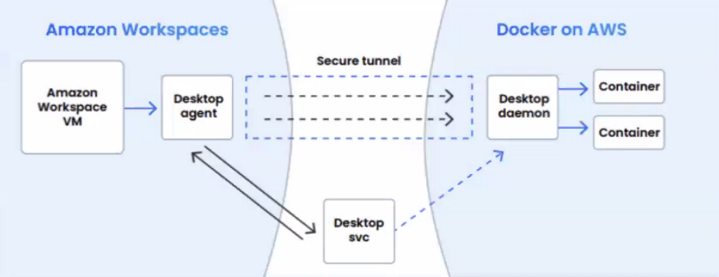Running Docker on Amazon WorkSpaces, has been challenging. Has Docker resolved this issue?
Last week, I attended a deep dive webinar on Docker Desktop for Amazon WorkSpaces (DDAW), a cloud-hosted Docker engine designed to address the challenges of running Docker within Amazon WorkSpaces. This post is simply a recap of the webinar, including data from the presentation and a few notes I took.
Challenges of running Docker on VDI
DDAW was developed to address several challenges associated with running Docker within virtual desktops:
- Nested Virtualization Requirement – Docker Desktop requires nested virtualization
- Complexity and Cost of On-prem VDI – On-prem VDI is complex to setup and expensive to operate
- Amazon WorkSpaces Limitation – Amazon WorkSpaces does not support nested virtualization. Other solutions are too costly
To successfully run Docker on Amazon WorkSpaces, a specialized solution that bypasses the need for nested virtualization is essential.
Docker Desktop for Amazon WorkSpaces
DDAW is a special version of Docker Desktop that allows developers to easily build, share, and run containerized applications for Server 2022 Windows Workspaces environments. Instead of loading the Docker engine locally, it communicates with the Docker service, which routes users to a Docker-managed instance running the Docker engine. The Docker-managed SaaS environment is currently deployed to 19 zones and supports sub-millisecond speeds to deliver a seamless, local-like Docker experience for WorkSpaces users.

DDAW Benefits:
- Ease of Use – Provides a cloud-hosted Docker engine that requires zero configuration or manual action
- Flexibility – Can support multiple deployment models, including a Docker-hosted, multi-tenant SaaS environment but in the future, will support Bring Your Own Cloud (AWS) configurations
- Cost efficiency – Ephemeral containers allow for smaller WorkSpace instances. The WorkSpace used for the demonstration was a 2vCPU, 4GB RAM instance. Since the Docker engine runs remotely, smaller instances may be used by your organization, saving you money.
- Security and Compliance – Enterprise-level encryption and VM-level isolation. Leverages the scalability and isolation provided by AWS EC2 instances, support secure communications over SSH.
- Improved User Experience – Low latency and local aware resource allocation
Join the POC
DDAW is currently available as a proof of concept (POC). If you’d like to participate, email amazon-workspaces@docker.com. The Docker team will have a call with yours to determine if your use case meets the POC criteria. If it does, Docker will send you a version of Docker Desktop compatible with WorkSpaces and ensure you everything you need for a successful POC.
Current Limitations
- The DDAW POC does not currently support Extensions, Docker Debug, or Registry Access Management
- DDAW currently works with Windows Server 2022 WorkSpaces but Server 2019 and Ubuntu support is “coming soon” though no timeframe was given (or I missed it).
Conclusion
In conclusion, Docker Desktop for Amazon WorkSpaces (DDAW) presents an innovative solution for organizations facing the challenges of running Docker on VDI environments. By eliminating the need for nested virtualization and offering a cloud-hosted Docker engine, DDAW simplifies the setup process and enhances the user experience. Join the POC to explore how DDAW can transform your development workflow.

